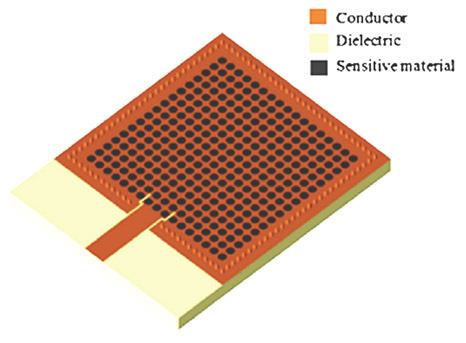Project title: Tunable RESOnant SENSors based on multi-layer substrate integrated waveguide technology
Acronym: ResoSens
Program: Information and Communication Technologies
Project category: Experimental-demonstrative
Contract No. 399PED/2019
Project duration: 2020 - 2022
About ResoSens
Summary
The project ResoSens aims to develop novel structures intended for resonant sensors based on substrate integrated waveguides (SIW) using two electromagnetically coupled SIW circuits combined into the same resonant circuit [1], [2]. A major advantage of this configuration consists in sensor's resonant frequency adjustment by variation of certain component value(s), or to provide continuous electronic tuning of the resonant frequency, without any layout modification. The two-part coupled SIW resonant structures can be used as resonant sensors by themselves as well as integrated with interdigitated (IDT) transducers covered by thin oxidic films for increased sensitivity.
ResoSens project involves two major research stages. First of all, the actual technical potential of sensors' structure will be investigated, since their layout configuration needs adequate theoretical and experimental support. Consequently, electromagnetic 3 D simulations and their validation on experimental models will allow the validation and improvement of the circuit models. The second research stage involves design, fabrication and electrical characterization of a resonant sensor model, as well as its optimization for final validation of the proposed concept. The resonant sensors will cover 5.15 – 5.725 GHz frequency band, which is specific to unlicensed short-range devices intended for small power wireless applications [3].
The project ResoSens aims to develop novel circuit techniques and structures intended for tunable resonant sensors based on substrate integrated waveguide (SIW) environment. This is justified due to complexity of currently available means for tuning SIW circuits, while their applicability in sensors has not yet been proven. The proposed resonant sensors are therefore intended to provide flexible and reliable solutions for monitoring environmental parameters measurements, particularly since regular RFID solutions may not be yet available for these applications.
The investigation of actual potential of novel tuning elements is essential since the proposed tuning procedure requires both suitable theoretical and experimental support. Therefore, both advantages and drawbacks of the new sensor structures will result from extensive simulations and experimental validation. In order to confirm the effectiveness of the proposed technical solutions related to the tunable SIW resonant sensors, a resonant sensor will be manufactured in both non-tunable (based on existing layout reported in literature) and its tunable versions.
Certain material properties depending on specific physical parameters of the environment are currently used for novel, high-performance sensors.
Therefore, the resonant frequency of most SIW cavities may be disturbed by changing the physical characteristics of some of their structural elements, or due to variation in the equivalent relative permittivity of dielectric material within SIW by partial penetration of the analyzed substance into the cavity.
 As an example, the thermal expansion coefficient of an alumina ceramic material has been used for temperature sensing in harsh environment. The temperature sensor shown in Fig. 1 [4] is based on a circular SIW cavity electromagnetically coupled with a dedicated external interrogation system by means of a rectangular aperture. The sensor covers full 30°C ‑ 1200°C temperature range with about 0.2 MHz/°C (or 91 ppm/°C) sensitivity, measured at 2.2 GHz operation frequency.
As an example, the thermal expansion coefficient of an alumina ceramic material has been used for temperature sensing in harsh environment. The temperature sensor shown in Fig. 1 [4] is based on a circular SIW cavity electromagnetically coupled with a dedicated external interrogation system by means of a rectangular aperture. The sensor covers full 30°C ‑ 1200°C temperature range with about 0.2 MHz/°C (or 91 ppm/°C) sensitivity, measured at 2.2 GHz operation frequency.

The detection principle used in SIW sensors for gases or substances in vapor state (analytes) is based on their access to the SIW cavity through a very large number of holes with small diameter. The presence of analytes inside the resonant cavity changes the resonant frequency of the sensor due to the variation of the equivalent permittivity of the total volume of dielectric material in the cavity. The sensitivity of these sensors can be improved by depositing layers of sensitizing material inside the structure.
Because the thermal expansion coefficient of the resonator’s dielectric substrate affects the measurement accuracy, additional cavities can be paired with the main sensor, for both temperature sensing and gas concentration reading correction. As an example, the hydrogen sensor shown in Fig. 2 has a sensitivity close to 6.64% relative frequency shift (272.7 MHz absolute value) functionalized with tin oxide (SnO2) micro-powder [5].
Bibliografie / References
-
V. Buiculescu, R. Rebigan, “Substrate integrated waveguide (SIW) based resonant sensors and methods for resonance frequency tuning of SIW resonant circuits”, Pending Patent A-00575 (Romania), Application date: 19 September 2019
-
V. Buiculescu, A. Nicoloiu, “Substrate integrated waveguide SPST switch with single SMD PIN diode”, Intl. European Microwave Conference - EuMW 2018, 23-28 Sept., Madrid, Spain
-
*** ERC Recommendation 70-03 relating the use of Short Range Devices – SRD
-
Qiulin Tan, Yanjie Guo, Lei Zhang, Fei Lu, Helei Dong, Jijun Xiong, "Substrate integrated waveguide (SIW)-based wireless temperature sensor for harsh environments", Sensors, vol. 18, no. 5, p. 1406, May 2018
-
M. Ndoye, H. El Matbouly, Y.N. Sama, D. Deslandes, F. Domingue. “Sensitivity evaluation of dielectric perturbed substrate integrated resonators for hydrogen detection”, Sens. Actuators A, Phys., vol. 251, pp. 198–206, Nov. 2016

